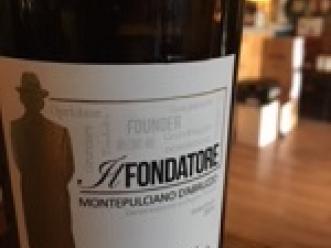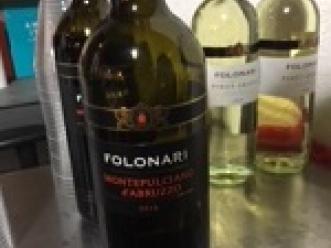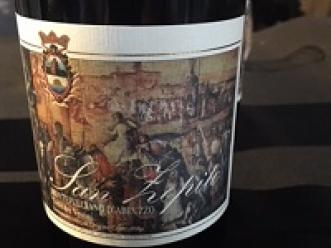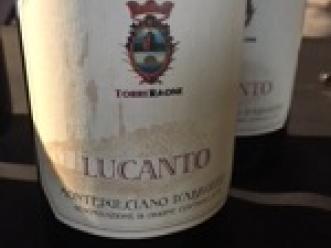Heading due east from Rome lays the region of Abruzzo. This is a historically poor region whose people inhabit the hills and mountains so prevalent in the province. The people are proud and independent. They resemble the peoples of Italy’s southern regions in attitude and aptitude. Likewise the food and wine cultures reflect that lack of affluence centered on a hard working community. The hillsides are excellent for viticulture. The most popular red grape is the Montepulciano although many other grapes are grown here most notably Sangiovese.
As an aside, there is no relation between the grape and the village of the same name in Tuscany, which is famous for its wine, Vin Nobile di Montepulciano (made from Sangiovese grapes.) White wine (not the subject of this article) is also made here. The Trebbiano grape is the most well known of the white varietals. Montepulciano d’Abruzzo and Trebbiano d’Abruzzo are two of my favorite wines from Italy and wines and deserve more recognition.
Montepulciano d’Abruzzo was designated as a DOC in 1968. It covers most of Abruzzo ranging from Molise in the south, the Marche in the north and inland against the Apennines Mountains. The wines are at least 85% Montepulciano with Sangiovese permitted, but not required, at up to 15%. The Riservas need to be aged a minimum of two years before release, with at least 6 months of that in wood. In 1995 another DOC was created called Montepulciano d’Abruzzo Colline Teramane. This was a carved out subset of the larger zone. The chief differences are that the wines must be at least 90% Montepulciano and the Riservas are aged a minimum of 3 years before release. Unlike other areas of Italy where smaller zones of quality wines were carved from larger ones, this DOC’s wines are not appreciably better (or worse) than the larger zone.
The Montepulciano grape is quite prolific. The Montepulciano grape grows easily in Abruzzo. It is plump with high amounts of juice. In an area this poor, this has been a boon to farmers wishing to take advantage of high yields. Unlike most other varietals, this grape makes nice wine even when produced in large quantities. The grape has a deep purple and ruby color to its juice. It has lower acidity (especially for an Italian varietal) and mild sweeter tannins. The resulting wines tend to be softer and more accessible than Chianti or Nebbiolo for example. Accordingly, the young wines are nice pleasurable reds that go as well with food as without it. Almost all of the wines at the low end of the price spectrum (and many can be found for under $8) are enjoyable. At the same time, Montepulciano d’Abruzzo can age brilliantly especially in the hands of the right producers.
At the top of the list of quality producers is Emidio Pepe. He has been making wines in this area since 1964. His grapes are produced organically and fermented in glass tanks for 18 to 24 months. His wines see no wood and no sulfur dioxide (a chemical treatment often used to prevent spoilage.) The wines are aged for a long time in glass bottles. When he is ready to sell his wines, they are rebottled in new bottles and released. They are some of the few Montepulciano d’Abruzzo’s which do not drink as well young. Pepe’s wines are fresh and powerful, yet rustic. They often have a raw barnyard quality to them, treasured by some and disliked by others. But they improve with age. In fact, his wines can easily last 20 to 30 years. His wines from the 1970’s and 1980’s are still available at retail (for over $200 per bottle) and are well worth the tariff. They are not easy wines to find, but they are some of the greatest red wines from Italy. Pepe’s wines are not for everyone, but for those who appreciate them (count me as one) they are astounding.
The wines of Edoardo Valentini are a close second to Pepe. Valentini’s wines are usually even more expensive and difficult to locate than Pepe’s. These are red wines that need long term cellaring and there is little reason to drink these young. At their pricing, they really do not start to deliver on their promise for 10 or 20 years. His wines are traditional and rustic. They often are slightly oxidized. One can imagine the great wines from this area being made this way one hundred years ago. They are powerful yet not as fresh as Pepe. Yet, they are complex and interesting and quite introspective. Valentini also makes a Trebbiano d’Abruzzo (the white wine of this region) that is just stunning.
There are other producers who make excellent Montepulciano d’Abruzzo’s that can be purchased without breaking the bank. The Masciarelli winery makes a basic Montepulciano d’Abruzzo that is available for under $10. It provides easy drinking cherry and red raspberry flavors in an accessible and slightly earthy drink. These wines will not improve much with age, but can be held for a few years without a problem. There really is no need to cellar these wines as they produce a quality wine almost every year. The winery also produces a better Montepulciano d’Abruzzo called Marina Cvetic. This more upscale wine is closer to $30 but will age wonderfully for twenty years.
Other producers I have liked include Illuminati, Cataldi Madonna, Faraone, Umani Ronchi and Valle Reale (especially the San Calisto bottling). The fact of the matter is that I have never tasted a poor Montepulciano d’Abruzzo. The grape lends itself to making quality wines at every price point. If you see a bottle in the grocery store, try it. If you want to explore what the heights this grape can reach in the hands of a master producer, pick up a bottle from one of the above named producers. I think you will be happy.
What foods could you serve with these wines? As always, start by looking to the local foods that developed alongside the wines. Abruzzo is known for its pork products and lamb dishes. Both are excellent serving ideas with Montepulciano d’Abruzzo. Hot and spicy peppers are also used heavily in the local cuisine. Pasta in red sauce is ubiquitous, of course. Montepulciano d’Abruzzo is a soft wine, with just a hint of acidity and tannins that make it hard to miss with these or almost anything else at the dinner table.
I hope you all go out and try a bottle or two and let me know what you think.
Loren Sonkin is an IntoWine.com Featured Contributor and the Founder/Winemaker at Sonkin Cellars.





